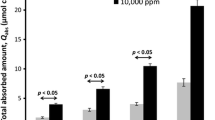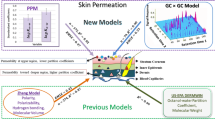Abstract
An in vitro study was carried out to elucidate the mechanisms controlling iontophoretic transport. The investigation focused on three areas, including the nature of the permeant (state of ionization and hydrophobicity), skin structures (hair follicle distribution and stratum corneum), and various parameters influencing iontophoresis (current, permeant concentration, and competitive ion effects). The data indicate that iontophoretic-facilitated transport is essentially pore mediated and that the transport of ionized and nonionized molecules may be enhanced through the pore-type pathway. The data presented show that iontophoresis has a detrimental effect on the lipoidal transport pathway and that the transport of more hydrophobic nonionized molecules is decreased compared with passive diffusion. The iontophoretic enhancement values decreased linearly with increasing alkyl chain length of n-alkanols. The iontophoretic permeability coefficients of ionized n-alkanoic acids was shown to decrease with increasing permeant hydrophobicity.
Similar content being viewed by others
REFERENCES
P. Tyle. Pharm. Res. 3:318–326 (1986).
H. A. Abramson and M. H. Gorin. J. Phys. Chem. 44:1094–1102 (1940).
R. Burnette and D. Marrero. J. Pharm. Sci. 75(8):738–743 (1986).
S. Grimnes. Acta Derm. Venereol. (Stockh.) 64:93–98 (1984).
N. H. Bellantone, S. Rim, M. L. Francoeur, and B. Rasadi. Int. J. Pharm. 30:63–72 (1986).
L. P. Gangarosa, N. H. Park, C. A. Wiggins, and J. M. Hill. J. Pharmacol. Exp. Ther. 21:377–381 (1980).
S. DelTerzo, C. R. Behl, R. A. Nash, N. H. Bellantone, and A. W. Malick. J. Soc. Cosmet. Chem. 37:297–307 (1986).
C. R. Behl, M. Barrett, G. L. Flynn, T. Kurihara, K. A. Walters, O. G. Gatmaitan, N. Harper, W. I. Higuchi, N. F. H. Ho, and C. L. Pierson. J. Pharm. Sci. 71:229–234 (1982).
W. I. Higuchi. Int. Conf. Pharm. Sci. Clin. Pharmacol. Abstr., Jerusalem, Israel, May–June, 1988, p. 62.
P. J. Niebergall. In A. Osol (ed.), Remington's Pharmaceutical Sciences, 16th ed., Mack, Easton, Pa., 1980, pp. 225–228.
R. J. Scheuplien and I. H. Blank. Physiol. Rev. 59:702–747 (1971).
C. R. Behl, N. H. Bellantone, and G. C. Flynn. In A. F. Kydonieus and B. Berner (eds.), Transdermal Delivery of Drugs, Vol. II, CRC Press, Boca Raton, Fla., 1985, pp. 109–132.
C. R. Behl, A. A. El-Sayed, and G. L. Flynn. J. Pharm. Sci. 72(1):79–85 (1983).
Author information
Authors and Affiliations
Rights and permissions
About this article
Cite this article
Del Terzo, S., Behl, C.R. & Nash, R.A. lontophoretic Transport of a Homologous Series of Ionized and Nonionized Model Compounds: Influence of Hydrophobicity and Mechanistic Interpretation. Pharm Res 6, 85–90 (1989). https://doi.org/10.1023/A:1015812005467
Issue Date:
DOI: https://doi.org/10.1023/A:1015812005467




